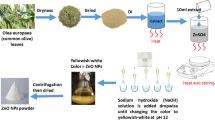Abstract
The aim of this study was to prepare samarium oxide nanoparticles (Sm2O3NPs) using curcumin and investigation of antimicrobial activities of the prepared NPs. Sm2O3NPs were synthesized using curcumin and characterized by TEM, XRD, FTIR, FESEM, and EDX analyses. Antibacterial and antibiofilm activities of the synthesized NPs against Pseudomonas aeruginosa and Staphylococcus aureus were investigated using well diffusion and crystal violet staining methods, respectively. Finally, the expression of virulence-related genes (toxA, exoS, fnbA, and fnbB) and efflux pump genes (mexA, mexB, norA, and norB) in studied strains were determined using quantitative polymerase chain reaction. Characterization of the synthesized Sm2O3NPs showed that the NPs have a cubic structure with an average size of 32.61 nm, and a pure crystalline phase. The Sm2O3NPs displayed significant antibacterial activity against studied strains. Moreover, Sm2O3NPs efficiently inhibited biofilm formation of P. aeruginosa and S. aureus by 48 ± 3.29 and 53 ± 1%, respectively. Also, the synthesized Sm2O3NPs significantly reduced the expression of toxA, exoS, mexB, fnbA, norA, norB genes, by 44, 27, 31, 53, 40, and 30%, respectively. However, the expression of fnbB and mexA did not significantly change. This study confirmed the promising antibacterial potential of Sm2O3NPs, which could be employed as an effective antibacterial agent against clinically multidrug-resistant strains after further characterization.







Similar content being viewed by others
References
M. C. Roco (2011). J. Nanopart. Res. 13, 2. https://doi.org/10.1007/s11051-010-0192-z.
I. Khan, K. Saeed, and I. Khan (2019). Arab. J. Chem. 12, 7. https://doi.org/10.1016/j.arabjc.2017.05.011.
N. Muniyappan, M. Pandeeswaran, and A. Amalraj (2021). Environ Chem Ecotoxicol. https://doi.org/10.1016/j.enceco.2021.01.002.
A. U. Khan, Y. Wei, Z. U. Haq Khan, K. Tahir, A. Ahmad, S. U. Khan, et al. (2016). Sep. Sci. Technol. 51, 1070. https://doi.org/10.1080/01496395.2016.1140203.
S. Li, Y. Shen, A. Xie, X. Yu, L. Qiu, L. Zhang, and Q. Zhang (2007). Green Chem. 9, 8. https://doi.org/10.1039/B615357G.
F. Ma, S. Xu, Z. Tang, Z. Li, and L. Zhang (2021). Biosaf. Health 3, 1. https://doi.org/10.1016/j.bsheal.2020.09.004.
N. D. Friedman, E. Temkin, and Y. Carmeli (2016). Clin. Microbiol. Infect. 22, 5. https://doi.org/10.1016/j.cmi.2015.12.002.
A. Kumari, R. Panda, M. K. Jha, J. R. Kumar, and J. Y. Lee (2015). Miner. Eng. 79, 102. https://doi.org/10.1016/j.mineng.2015.05.003.
V. Zepf, and W.L. In Filho, (eds.), (Elsevier, Boston, 2016), pp. 3–17.
Z. Yu, C. Eich, and L. J. Cruz (2020). Front Chem. https://doi.org/10.3389/fchem.2020.00496.
M. Tourbin, A. Al-Kattan, and C. Drouet (2014). Powder Technol. 255, 17–22. https://doi.org/10.1016/j.powtec.2013.08.008.
S. Dasari, Z. Abbas, P. Kumar, and A. K. Patra (2016). CrystEngComm. 18, 23. https://doi.org/10.1039/c5ce02387d.
CLSI, Performance Standards for Antimicrobial Susceptibility Testing, 28th ed. (CLSI Supplement M100 Clinical and Laboratory Standards Institute, Wayne, 2018).
L. Wang, C. Hu, and L. Shao (2017). Int. J. Nanomed. 12, 1227. https://doi.org/10.2147/ijn.s121956.
S. Das and H. R. Dash, Microbial Biotechnology: A Laboratory Manual for Bacterial Systems (Springer, New Delhi, 2014).
M. W. Pfaffl (2001). Nucleic Acids Res. 29, 9. https://doi.org/10.1093/nar/29.9.e45.
R. C. Massey, M. N. Kantzanou, T. Fowler, N. P. J. Day, K. Schofield, E. R. Wann, A. R. Berendt, M. Hook, and S. J. Peacock (2001). Cell Microbiol. 3, 12. https://doi.org/10.1046/j.1462-5822.2001.00157.x.
X. He and J. Ahn (2011). FEMS Microbiol. Lett. 325, 2. https://doi.org/10.1111/j.1574-6968.2011.02429.x.
N. Fazeli and H. Momtaz (2014). Iran. Red Crescent Med. J. 16, 10. https://doi.org/10.5812/ircmj.15722.
M. R. Arabestani, M. Rajabpour, R. Y. Mashouf, M. Y. Alikhani, and S. M. Mousavi (2014). Arch. Iran. Med. 18, 102–108.
K. Yoneda, H. Chikumi, T. Murata, N. Gotoh, H. Yamamoto, H. Fujiwara, T. Nishino, and E. Shimizu (2005). FEMS Microbiol. Lett. 243, 1. https://doi.org/10.1016/j.femsle.2004.11.048.
K. Ahmadi, A. Hashemian, E. Bolvardi, and P. Hosseini (2016). Med. Arch. 70, 1. https://doi.org/10.5455/medarh.2016.70.57-60.
B. Aderibigbe (2017). Molecules 22, 8. https://doi.org/10.3390/molecules22081370.
D. A. Atwood, Inorganic Chemistry (Wiley, Hoboken, 2013).
M. Idrees, S. Sawant, N. Karodia, and A. Rahman (2021). Int. J. Environ. Res. Public Health 18, 14. https://doi.org/10.3390/ijerph18147602.
S. Chevalier, E. Bouffartigues, J. Bodilis, O. Maillot, O. Lesouhaitier, M. G. J. Feuilloley, N. Orange, A. Dufour, and P. Cornelis (2017). FEMS Microbiol. Lett. 41, 5. https://doi.org/10.1093/femsre/fux020.
K. Velsankar, S. Sudhahar, G. Parvathy, and R. Kaliammal (2020). Mater. Chem. Phys. 239, 121976. https://doi.org/10.1016/j.matchemphys.2019.121976.
S. L. Iconaru, A. Groza, S. Gaiaschi, K. Rokosz, S. Raaen, S. C. Ciobanu, P. Chapon, and D. Predoi (2020). Coatings 10, 11. https://doi.org/10.3390/coatings10111124.
S. Shi, J. Jia, X. Guo, Y. Zhao, D. Chen, Y. Guo, and X. Zhang (2016). Int. J. Nanomed. 11, 6499. https://doi.org/10.2147/ijn.s41371.
S. Fulaz, H. Devlin, S. Vitale, L. Quinn, J. P. O’Gara, and E. Casey (2020). Int. J. Nanomed. 15, 4799. https://doi.org/10.2147/ijn.s256227.
T. Rasamiravaka, Q. Labtani, P. Duez, and M. El Jaziri (2015). Biomed. Res. Int. 2015, 1–17. https://doi.org/10.1155/2015/759348.
L. Shkodenko, I. Kassirov, and E. Koshel (2020). Microorganisms 8, 10. https://doi.org/10.3390/microorganisms8101545.
S. Armstrong, S. P. Yates, and A. R. Merrill (2002). J. Biol. Chem. 277, 48. https://doi.org/10.1074/jbc.m206916200.
J. Coburn, S. T. Dillon, B. H. Iglewski, and D. M. Gill (1989). Infect Immun. 57, 3. https://doi.org/10.1128/iai.57.3.996-998.1989.
K. Rice, M. Huesca, D. Vaz, and M. J. McGavin (2001). Infect Immun. 69, 6. https://doi.org/10.1128/iai.69.6.3791-3799.2001.
A. Sirelkhatim, S. Mahmud, A. Seeni, N. H. M. Kaus, L. C. Ann, S. K. M. Bakhori, H. Hasan, and D. Mohamad (2015). Nano-Micro Lett. 7, 3. https://doi.org/10.1007/s40820-015-0040-x.
D. Nehme and K. Poole (2007). J. Bacteriol. 189, 17. https://doi.org/10.1128/jb.00718-07.
D. Gupta, A. Singh, and A. U. Khan (2017). Nanoscale Res Lett. 12, 1. https://doi.org/10.1186/s11671-017-2222-6.
N. Pourmehdi, Z. Moradi-Shoeili, A. Sadat Naeemi, and A. Salehzadeh (2020). Chem. Biodivers. 17, 6. https://doi.org/10.1002/cbdv.202000072.
Funding
This research did not receive any specific grant from funding agencies in the public, commercial, or not-for-profit sector.
Author information
Authors and Affiliations
Corresponding author
Ethics declarations
Conflict of interest
The authors report no declarations of interest.
Additional information
Publisher's Note
Springer Nature remains neutral with regard to jurisdictional claims in published maps and institutional affiliations.
Rights and permissions
About this article
Cite this article
Zahmatkesh, H., Mirpour, M., Zamani, H. et al. Effect of Samarium Oxide Nanoparticles Fabricated by Curcumin on Efflux Pump and Virulence Genes Expression in MDR Pseudomonas aeruginosa and Staphylococcus aureus. J Clust Sci 34, 1227–1235 (2023). https://doi.org/10.1007/s10876-022-02274-x
Received:
Accepted:
Published:
Issue Date:
DOI: https://doi.org/10.1007/s10876-022-02274-x




